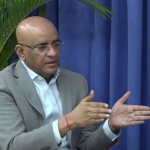
Although Guyana will be pumping billions of dollars into the gas to energy project at Wales, the Government will still be saddled with another price tag for the purchase of the delivered gas.
At a press conference today, President of ExxonMobil Guyana Alistair Routledge while maintaining that the company will not rake in any profit from the sale of the gas to Guyana, the country will still have to carry the price tag for the supplied gas.
The multibillion-dollar project, which includes the construction of a 300-megawatt power plant, is expected to be completed by December 2024.
Prime Minister Mark Phillips recently announced that Exxon’s affiliate – Esso Exploration and Production Guyana Limited (EEPGL) – will inject US$1B to foot the cost to construct the pipeline.
At the press conference today, the Exxon President confirmed the company’s investment to construct the pipeline, but noted that the cost will be recovered through the ‘sale’ of the gas to the operators of the power plant.
“We are making an investment that is incremental to the original developments offshore in order to transport the gas onshore. That’s mostly the pipeline and that’s several hundred million dollars-worth of investment and so, in some way it needs to recover that cost. So, the way that’s been agreed as well, okay, let’s make sure that that price is put on the gas that reflects just that cost of infrastructure, non-profit, just the cost of infrastructure,” Mr Routledge explained.
Mr. Routledge emphasized that there will be “no profit element,” and the revenues received from the production and delivery of the gas will be used to cover the cost of the pipeline’s infrastructure.
“The gas itself, we are selling the full 50 million cubic feet a day to the government or a government entity that’s being established in order to receive the gas, and put it through the power station. And at that point, the government takes control of the gas and the associated natural gas liquids, and can determine if all of the gas flows into the power station, if needed or does it go into some kind of industry,” the ExxonMobil Guyana President explained.
The official said based on studies done, Exxon will be able to release up to 50 million cubic feet of gas per day without impacting the recovery of the oil.
Once the cost to construct the pipeline is fully recovered, the profit will be split.
“The cost recovery mechanism is very clear in the contract. When costs are recovered, then all other revenues go into the profit side of the calculation and then those are split with the government, the country and the investors,” Mr Routledge said.

The ExxonMobil Guyana President said through the arrangement with the Government, gas would be delivered to the operators of the power plant at an extremely low price when compared to the international market.
President Irfaan Ali has repeatedly stated that there will be an almost 50% reduction in the cost of power generation once the facility goes into operation.
For ExxonMobil, it is a win-win situation.
“For us, what motivates us on gas-to-energy is that we can clearly see the benefit for the country. We came to the country wanting to ensure that everyone benefits, clearly it needs to be a win-win-win. As our chairman said recently, it needs to be a win for the investors of course, otherwise, it doesn’t attract investment. There needs to be a win for the government and its ambition to develop the country and ultimately, for all the citizens of the country,” Mr Routledge reasoned.
Routledge also noted the impact would be positively felt across sector and ExxonMobil is pleased to be a part of the process.
“It will deliver secure energy. There will no longer be the same requirement to import fuel oil to the to the current power plants, and it will be lower emissions and so lower costs, less dependence on external energy sources and markets,” he added.
In January, Prime Minister Mark Phillips told the National Assembly that while Government is funding the engineering, procurement and construction (EPC) costs for the Power Plant and the Natural Gas Liquids (NGL) plant, it will be required to repay EEPGL over a 20-year-period for the construction of the pipeline.
Concerned over the financial arrangement for the entire project, the Opposition APNU+AFC has since filed a Parliamentary Motion to have the Government hand over all of the documents related to the multibillion-dollar project.

















You must be logged in to post a comment Login